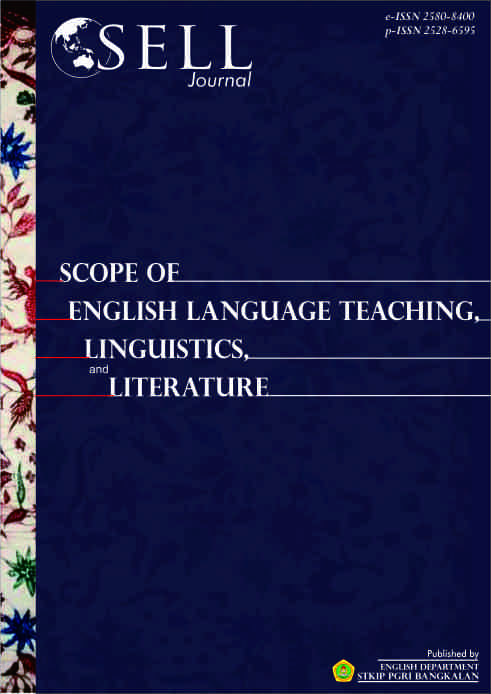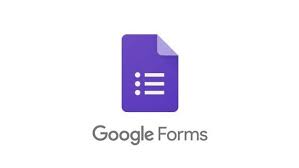An Analysis of YouTube Tourism Video in Teaching Students' Speaking Skill
DOI:
https://doi.org/10.31597/sl.v8i01.903Keywords:
Speaking skill, YouTube Tourism Video, YouTubeAbstract
Currently, rapidly developing technology has been used in education. YouTube is one of the technologies that can be used as an effective learning media in speaking skills of each student, especially speaking. This study aims to describe the implementation and the students’ responses toward the use of YouTube tourism video in teaching students’ speaking skill. The method in this study used qualitative research which focus on case study research. It involved the eleventh-grade students of SMAN 3 Bangkalan as the subject of the research. The data were obtained through the observation during the teaching and learning process and an interview with the students. In this study, the researcher accomplished several steps to analyse the data, namely organizing and familiarizing, coding and reducing, interpreting and representing. The first research findings reveal that YouTube Tourism videos are used by teachers and students inside and outside the classroom. Teachers take advantage of YouTube tourism to provide writing assignments, speaking assignments and feedback on students' speaking. Meanwhile, students use YouTube to provide corrections and suggestions to their friends. The second finding revealed that students gave positive responses on the use of YouTube Tourism in speaking. The students say that YouTube is media that is easy to use, effective, and attractive. It also develops students writing and speaking skills are able to motivate students in speaking.
References
Thornbury. (2005). In How to Teach Speaking (p. 96). Vermont, USA: Pearson Education ESL.
Abdulrahman Almurashi, W. (2016). He Effective Use of Youtube Videos for Teaching. International Journal of English Language and Linguistics Research, 32-47.
Abidah, A. H. (2020). The Impact of Covid-19 to Indonesian Education and Its Relation to the Philosophy of “Merdeka Belajar.” . Studies in Philosophy of Science and Education, 1(1),, 38-49.
Apuke, O. D. (2018). University students‟ Usage Of The Internet Resources For Research and Learning. forms of access and perceptions of utility Heliyon, 4-12.
Ayu, L. P. (2016). YouTube Videos in Teaching Listening: The benefits in Experts’ Views. In Research in English and Education (READ) (Vol. 1, Issue 2).
Bailey., M. (2002). Practical English Language Teaching Speaking New York: Mc Graw. 35.
Beller. (2013). Technologies in Large-Scale Assessment:. New Directions, Challenges, and Oppurtunities.
Brown, D. H. (2004). Language. New york.
Brown, H. (2001). Teaching by Principles : An Active Approch to Language Pedagogy. San Francisco: Addison wasley longman, Inc.
Fitriani, F., Nur, R. H., Bustamin, B., Ali, S. M., & Nurisman, N. (2019). Improving Students’ Descriptive Text Writing by Using Writing in the Here and Now Strategy at the Tenth Grade Students of Vocational High School. International Journal for Educational and Vocational Studies, 1(6). https://doi.org/10.29103/ijevs.v1i6.1802
Fulcher, G. (2003). Testing Language Second Language Speaking. Sydney: Longman.
Gunada, I. W. (2018). Using YouTube Video ; An IT based Media to Improve Students ’ Speaking Skill.
Hanurawan, F. (2012). Metode penelitian kualitatif dalam ilmu psikologi Surabaya. Komisi Peningkatan Kinerja Masyarakat (KPKM) Universitas Airlangga.
Haris Mayekti, M., Faiza, D., Christanty, A., & Bestari, Y. (n.d.). An Analysis of Writing Descriptive Text at the Second Semester Students’ English Language Teaching UNU Purwokerto. In English Education, Linguistics, and Literature Journal (Vol. 1, Issue 1). https://jurnal.unupurwokerto.ac.id/index.php/educalitra
Harmer, J. (2003). How to Teach Grammar. London: Longman.
Harmer, J. (2007). The Practice of English Language Teaching,. England : Pearson Education
Hia, M. (2021). THE EFFECT OF USING YOUTUBE ON STUDENTS’ MOTIVATION IN LEARNING ENGLISH VOCABULARY. In Dialectical Literature and Education Journal (DLEJ (Vol. 6, Issue 2). https://dlejpancasakti.ac.id/index.php/dlejpancasakti
Hudges, R. (2002). Teaching and Researching Speaking. New York: Pearson Education.
Prasetianing Jati, I., Saukah, A., Suryati, N., & YBPK Ngoro-Jombang, S. (2019). Suryati-Teaching Using YouTube Turorial Video to. In Jurnal Pendidikan Humaniora (Vol. 7, Issue 3). http://journal.um.ac.id/index.php/jphISSN:2338-8110
Khaliq, A., & Nasution, R. (2019). YouTube as a Media in English Language Teaching (ELT) Context: Teaching Procedure Text ARTICLE HISTORY (Vol. 1, Issue 1). http://ojs.journal.unilak.ac.id/index.php/utamax
Kurniati, A. (n.d.). A STUDY ON THE SPEAKING ABILITY OF THE SECOND YEAR STUDENTS OF SMK TELKOM PEKANBARU STUDI TENTANG KEMAMPUAN SPEAKING SISWA KELAS DUA SMK TELKOM PEKANBARU.
Leong, L. M., & Ahmadi, S. M. (2017). An Analyis of Factors Influencing Learners' English Speaking Skill. International Journal of Research in English Education.
Mazouzi, S. (2013). Analysis of Some Factors Affecting Learners' Oral Performance. International Journal of Research in English Education, 36.
Nur Syafiq, A., Rahmawati, A., & Oktaviana, T. (2021). Increasing Speaking Skill through YouTube Video as English Learning Material during Online Learning in Pandemic Covid-19 ARTICLE HISTORY. In Elsya : Journal of English Language Studies (Vol. 3, Issue 1). http://ojs.journal.unilak.ac.id/index.php/elsya
Nunan, D. (2003). Practical English Language Teaching . New York
Paulus, Y., & Erfiani, F. (2017). Improving Second Semester Students’ Speaking Ability Through Storytelling Learning Model at English Study Program of Timor University (A Classroom Action Research Method). In Journal of English Language (Vol. 1, Issue 2). Literature, and Teaching.
Pollard, A. (2008). Evidence Informed. In Reflective Teaching 3 (p. 34). Continuum International Publishing Group.
Raja, R., & Nagasubramani, P. C. (2018). Recent Trend of Teaching Methods in Education" Organised by Sri Sai Bharath College of Education Dindigul-624710. India Journal of Applied and Advanced Research, 2018(3), 33–35. https://doi.org/10.21839/jaar.2018.v3S1.165
Riswandi, D. (2016). Use of YouTube-Based Videos to Improve Student... Diki Riswandi Proceeding The 2 nd International Conference On Teacher Training and Education Sebelas Maret University Use of YouTube-Based Videos to Improve Students’ Speaking Skill (Vol. 2). www.YouTube.com
Rosianta, E., & Sabri, M. (2018). THE MAKING OF PROMOTIONAL VIDEO OF TOURISM IN RUPAT ISLAND. INOVISH JOURNAL, 3(1).
Sayuri, S. (2016). Problems in Speaking Faced By EFL Students of Mulawarman University. Indonesia Journal of EFL and Linguistics. , 47-61.
Shute, V. J. (2007 ). Review of Computer Based Assessment for . Journal of Computer
Skill, T. S. (2003). Teaching Speaking Skill. New York
Sudijono, A. (2003). Pengantar Statistik Pendidikan. Jakarta : PT. Raja Grafindo Persada.
Syebania, B., & Iman, J. N. (2018). The Effectiveness of Tourism Videos to Improve The Tenth Grade Students’ Speaking Achievement in SMKN 6 Palembang. 7(1).
Thornbury. (2005 ). How to Teach Speaking. Vermont, USA: Pearson Education ESL.
Thornbury, S. (2005). How to Teach Speaking. Harmer J (Ed): London:Longman.
Wael Abdulrahaman, A. (2016). The effectives Use of YouTube video for teaching english. International journal english language and lingusitics research, 32-47.
Wasim, S. (2019). Qualitative v/s. Quantitative Research- A Summarized Review. J. Evid. Based Med. Healthc., pISSN- 2349-2562, eISSN- 2349-2570/ Vol. 6/Issue 43/Oct. 28, 2019, 2829.
Zaharah, G. I. (2020). Impact of Corona Virus Outbreak Towards Teaching and Learning Activities in Indonesia. Jurnal Sosial & Budaya Syar-i .
Downloads
Published
How to Cite
Issue
Section
License
1. Copyright of this journal is possession of Editorial Board and Journal Manager, by the knowledge of author, whilst the moral right of the publication belongs to the author.
2. Legal formal aspect of journal publication accessibility refers to Creative Commons Atribution-ShareAlike (CC BY-SA), implies that this license lets others remix, adapt, and build upon your work even for commercial purposes, as long as they credit you and license their new creations under the identical terms. This license is often compared to “copyleft” free and open source software licenses.
3. Every publications (printed/electronic) are open access for educational purposes, research, and library. Other that the aims mentioned above, editorial board is not responsible for copyright violation















